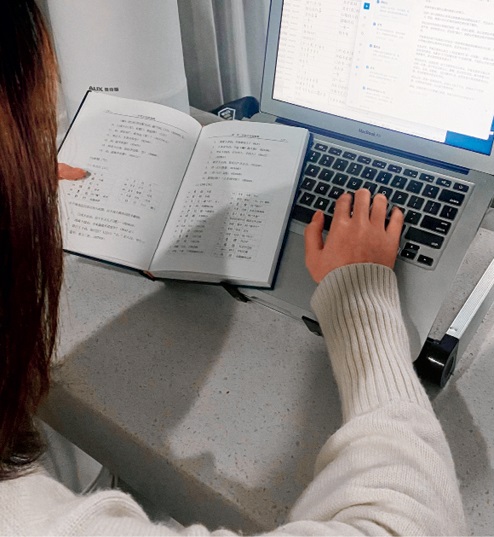Old Divinations, New Development

Li Ying first came across the oracle bone script when she was a sophomore studying ancient Chinese language.
“Will it not rain when we arrive at dusk?” Someone wanted to know this very simple thing, which however, has become part and parcel of China’s history today because of its antiquity. The question, asked during the Shang Dynasty (1600-1046 BC), the second dynasty in China’s history, is the subject of linguistic research today as it is part of the oracle bone divinations: questions engraved on animal bones or shells that were then burned in the belief that the gods would answer the questions by manifesting signs in ember. The oracle bone writings are mainly the records of the divinations made by the Shang people and the earliest form of Chinese characters found so far.
Similar to the ancient Egyptian hieroglyphics, the oracle bone script was mainly used about 4,000 years ago and was lost after the Shang Dynasty collapsed. In modern China, while historians, scholars, and researchers constitute the main communities studying the script, recently, it has become part of the social media. Thanks to the efforts of a young researcher, more and more members of the general public are becoming aware of its charm and significance.

Li Ying is recording a video.
Bonding with Bones
Li Ying first came across the oracle bone script when she was a sophomore studying ancient Chinese language. The teacher explained how the characters were created, why they were created that way, and how the script evolved. Li was struck by the wisdom of the ancient people; the character for the word “dusk”(written as “暮” in simplified Chinese) particularly left a deep impression on her. In the oracle bone script, it’s represented by the character “
 ”, which has a sun (日) at the center surrounded by four stalks of grass, meaning the sun sets into the grass. In some variations, the grass is replaced by two trees or two ears of millet, depending on the environment of the engraver.
”, which has a sun (日) at the center surrounded by four stalks of grass, meaning the sun sets into the grass. In some variations, the grass is replaced by two trees or two ears of millet, depending on the environment of the engraver.
Li chose to study the script during her postgraduate studies, but despite her keen interest, it was not an easy task. In the first year, her supervisor asked her to read a primer on the ancient characters but it was so difficult that she could read only two pages a day at the start. And even then, she had many questions. She spent a lot of time looking up related information, and it took her two months to finish the book. However, through her labor, she gained a great amount of knowledge about the oracle bone script and how to study it. In the second year, she and a few other students would go to the supervisor’s house, spending a long time learning how to decode the characters.
The script gave Li a window into the lives of ancient Chinese people and their thinking. The constant reading and research made them a part of her life. Then she decided to share the legacy with others.

Li Ying is writing a script for a short video to promote oracle bone characters.
Taking the Road Less Traveled
After getting her MA, Li had worked in the field of new media for over one year, writing scripts and other content for customers on Douyin, the hugely popular short video app. She wrote about trending topics and relationships and made commercial advertisements. But in her heart, she was not interested in these subjects. Instead, she wanted to write about Chinese culture. So she quit the job, giving herself three months to do something that she really wanted to do.
The result was her first video on oracle bone characters, which she posted on Douyin in February. It went viral and Li, known as Li Youxi on social media, realized that a great number of people were interested in the oracle bone script. From then, she began to post short videos on the subject on social media. The first character she explained was “dusk.” Her videos explain the meaning, evolution, and stories related to different characters. They also combine details on critical events of those times against a modern background.
For instance, on National Disaster Prevention and Reduction Day, observed on May 12, she explained how the ancient people reacted to disasters which are reflected in the ancient characters; On Mother’s Day, she spoke about the relationships among the characters woman (女), wife (妻), pregnancy (孕), and mother (母). Her vivid depictions make people realize that they share many similar things and emotions with their ancestors. Just as they worry about the weather, pray for the well-being of loved ones, and fret over obesity, so did the ancients. And in this way, they feel the universality of the oracle bone script and the wisdom of the ancient people.
However, it’s not easy to make short videos. “The first few were easy because I had accumulated some interesting material. But after that, it started becoming increasingly hard,” Li said. So now Li has to bone up on the script, looking up unfamiliar characters in dictionaries and doing extensive reading. Sometimes, it takes her two to three days to prepare a presentation to an interesting character. Sometimes, she finds herself at a dead end and has to start all over again.
To Li’s delight, the feedback she gets is mostly positive. Many parents ask her to recommend books for their children, who are also interested in the ancient characters. Some even ask if she would like to give classes. Some Chinese teachers ask to borrow her videos for their classes. Such comments encourage Li to continue her labor of love.
Making the videos has also improved her grasp of the ancient characters and she is on her way to becoming an expert.

In a shopping mall in Xi’an, the creative exhibition of oracle bone inscriptions collected by the National Library of China, attracts many citizens on July 21, 2021.
From Past to Present
The first scholastic discovery of the oracle bones was made during an excavation in central China in 1899. By 1997, they had become part of the UNESCO Memory of the World Register. About 150,000 oracle bones have been discovered so far, shedding light on the origin of Chinese characters, Chinese culture and the Chinese civilization. However, though they contain over 4,000 characters, only about one-third have been decoded with the interpretations agreed upon by scholars.
Despite its great significance, decoding the script is hampered by lack of expertise. The subject of ancient Chinese characters was listed as a postgraduate major only in 2021. Before that, it was just a postgraduation subject. The move is expected to cultivate more researchers in this field.
Li has achieved her three-month goal and now she has a new one: making 100 short videos on the oracle bone script. Her popularity is also spreading offline. She says many publishers have contacted her, asking her to write a book. “I think I’ll first make 100 videos, which will mean accumulating more materials. After that, I’ll consider writing a book,” she says.
Her videos are quickly growing in popularity. One viewer, eager for more, asks in a tone mimicking the divination about rain: “Will Li post more new videos?” 
Related articles
-
 An appetizing approach to food
An appetizing approach to foodMore
-
 Illiterate at 60, grandmother now author of six books at 87
Illiterate at 60, grandmother now author of six books at 87More
-
 2023 'Beijing Author Day' unveiled to upgrade transnational literary exchanges
2023 'Beijing Author Day' unveiled to upgrade transnational literary exchangesMore
-
 The master of translation
The master of translationMore
-
 Chinese novel set to be published in Thai
Chinese novel set to be published in ThaiMore
-
 Studies of master Qi Baishi to intensified, calls academy's annual conference
Studies of master Qi Baishi to intensified, calls academy's annual conferenceMore
